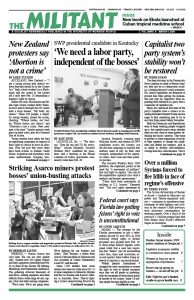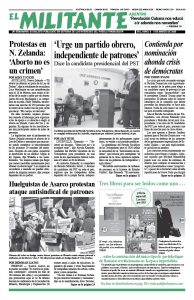The Syrian dictatorship of Bashar al-Assad — backed by Moscow’s air power and Tehran-organized militias — continues its murderous bombardment of rebel fighters and civilians in the country’s Idlib province, with disastrous consequences for working people. Over a third of the province’s 3 million people have fled their homes since Assad’s offensive began in December.
Turkey is already home to some 3.7 million Syrian refugees and its regime has closed the border to those fleeing Assad’s current offensive. Thousands trying to escape the onslaught have no shelter and are sleeping with little protection from freezing winter conditions. Whole villages and towns in the province are being abandoned before the regime’s airstrikes turn them into ruins. Assad’s forces target hospitals, forcing seven to close in the last week.
The Syrian government is attempting to crush all opponents, including reactionary Islamist forces that seized control of Idlib in the course of the country’s civil war. Since 2018 the province has been the last remaining part of Syria west of the Euphrates River beyond government control. Assad claims his offensive is the “prelude for complete victory.”
He neglects to mention a wide region in the country’s northeast, which is under the control of the Kurdish-led Syrian Democratic Forces, backed by U.S. ground and air power. Much of this territory was conquered from Islamic State occupation.
Syria’s civil war followed a mass political uprising in 2011 that was inspired by the “Arab Spring” mobilizations for political rights in Tunisia and Egypt that brought down widely hated regimes. Working people and others across Syria mobilized to demand an end to Assad’s rule.
Their uprising turned into a civil war after his regime moved to crush the protests in blood. In the fighting that followed Assad lost control of most of the country. And rival capitalist powers — Washington, Moscow, Ankara and Tehran — intervened to advance their own predatory interests. Islamic State and its oppressive military also made gains in both Syria and Iraq.
In 2015 Moscow intervened on behalf of its Syrian ally, mounting airstrikes alongside the intervention of militias organized by the rulers in Iran. These were decisive in shoring up Assad’s crumbling regime and his demoralized army. Over 400,000 people have been killed in the course of the civil war and over half the country’s population has been forced to flee their homes. Many escaped to opposition-held Idlib, hoping it would be safe, and that they could relaunch an offensive against Assad from there.
‘We hate the regime’
“We have a hatred against the regime and we won’t back down,” Naeem Uthman told the Wall Street Journal in Idlib Feb. 20. Uthman had fled there with his family in 2018, after government forces retook the suburb of eastern Ghouta in Damascus where they had lived and fought.
The Russian government intervened in Syria’s civil war to secure its political reach in the Middle East and maintain its only naval base on the Mediterranean Sea at Tartus. The rulers in Tehran have also extended the military bases they operate across Syria.
The Turkish government, which finances and backs some Syrian opposition forces, is a bitter foe of both Assad and the Kurds. Ankara deployed 5,000 troops to Idlib in early February to try and slow the Syrian regime’s advance. In the province of Aleppo its forces are preventing further progress by Assad’s forces and their allies, and in Idlib they provided cover artillery fire Feb. 20 to rebel attacks on Syrian government positions.
The Turkish rulers’ main motivation for intervening is their fear of the impact on Kurds in Turkey of the autonomous region Syrian Kurds have carved out just across the border. Some 30 million Kurds in the region have faced violent repression from the rulers of Iraq, Iran, Syria and Turkey whenever they have fought against the systematic denial of their national rights and sovereignty.
Ankara pivots toward Washington
Turkish President Recep Tayyip Erdogan had tried to form a bloc with Moscow to enforce a cease fire in Syria to allow Ankara to focus on attacking the Kurds. But Moscow instead has used its air power to back Assad’s ongoing assaults. And now more and more Syrians are massed at the Turkish border.
Facing the prospect of intensifying attacks on its forces and allies in Idlib, the Turkish government turned to Washington and asked for a Patriot missile defense system to shield its troops. It also requests Washington conduct aerial patrols in airspace Ankara controls in areas neighboring Idlib as a show of support. The U.S. government, which wields by far the strongest air power of the rival forces vying for influence in Syria, has so far not responded publicly to these requests.
Washington wants to use the current conflict to drive a wedge between the Turkish government — its NATO “ally” — and Moscow. In his effort to get a bloc with Russian President Vladimir Putin, Erdogan had earlier spurned Washington’s offer of Patriot missiles, instead agreeing to deploy a Russian-made S-400 defense system inside Turkey.
The Syrian government and its backers retook southwestern parts of the country from rebels in 2018. But to free up troops for the Idlib offensive and to defend these positions from continued insurgent attacks, Assad is dependent on the armed forces of Hezbollah from Lebanon and other militias organized by the Iranian rulers. Both Hezbollah and Tehran are stepping up their recruitment from among the local population there, offering financial inducements to those joining their forces. And they are increasingly integrating their armed units into the Syrian state structure.

